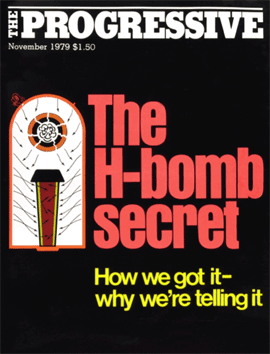The United States v. The Progressive 476 F. Supp 990 (W.D. Wis. 1979) case involved one of the few court decisions in American history that issued an injunction to prevent the publication of a story.
It spurred an ongoing legal debate regarding the proper balance between national security and the public’s right to know. The immediate issue raised in the case was the classification of information describing how to construct and detonate a hydrogen bomb (H-bomb).
The Progressive tried to publish article describing construction of an H-bomb
In 1979, the U.S. government invoked the Atomic Energy Act of 1954 to prevent the publication in The Progressive magazine of an article by freelance writer Howard Morland titled “The H-Bomb Secret: To Know How Is to Ask Why.”
The editors claimed that the article would provide the public with the information essential to understanding current issues regarding the production and use of nuclear weapons. The government claimed that publication would reveal vital national secrets and assist others in constructing a fusion bomb. Morland asserted that all information had been taken from unclassified sources; the government responded that the article revealed restricted data.
District court judge issued an injuction to prevent publication of the article
U.S. district court judge Robert W. Warren issued a temporary restraining order on March 9, 1979, enjoining publication of the article and ordering an immediate hearing.
On March 26, Judge Warren issued a preliminary injunction based on his findings during the hearing. He recognized the importance of the prior restraint imposed by the injunction, noting, “A mistake in ruling against The Progressive will seriously infringe cherished First Amendment rights.”

Howard Morland, who wrote the article about how to construct and detonate the H-bomb, is shown here in a 2008 photo. After the H-bomb’s secret was published by other publications, the government abandoned its efforts to enjoin Morland’s article. (Image via Flickr, CC BY 2.0)
Judge said no ‘plausible reason’ why public needed to know H-bomb details
Nevertheless, he drew the balance in favor of restriction, stating, “A mistake in ruling against the United States could pave the way for thermonuclear annihilation for us all.”
He could identify “no plausible reason why the public needs to know the technical details about hydrogen bomb construction to carry on an informed debate on this issue.” Judge Warren referenced the Atomic Energy Act, which designates that information relating to the design, manufacture, production, or utilization of atomic weapons is “born secret” — classified from conception — and therefore can be declassified only by the Department of Energy.
The Progressive appealed the restraining order.
After other newspapers published H-bomb secret, government abandoned injunction effort
The injunction sparked a series of classification decisions. The Progressive requested that Judge Warren lift the injunction; Judge Warren’s responding opinion was classified, and the defendants were denied permission to read it.
Physicists at the Argonne National Laboratory wrote to Senator John Glenn, identifying published sources of information revealing the secret of the H-bomb; the Department of Energy classified the letter, but seven newspapers subsequently published it. When a concerned citizen, Charles Hansen, disclosed the secret in a letter to Senator Charles Percy, one newspaper published the letter and several others threatened to do so.
Once the H-bomb secret was revealed, the government abandoned its efforts to restrain publication, and the Seventh Circuit Court of Appeals vacated the preliminary injunction. The Progressive published Morland’s article in November 1979, but Judge Warren’s opinion continues to provide precedent for future judicial classification decisions.
This article was originally published in 2009. Richard A. “Tony” Parker is an Emeritus Professor of Speech Communication at Northern Arizona University. He is the editor of Speech on Trial: Communication Perspectives On Landmark Supreme Court Decisions which received the Franklyn S. Haiman Award for Distinguished Scholarship in Freedom of Expression from the National Communication Association in 1994.

